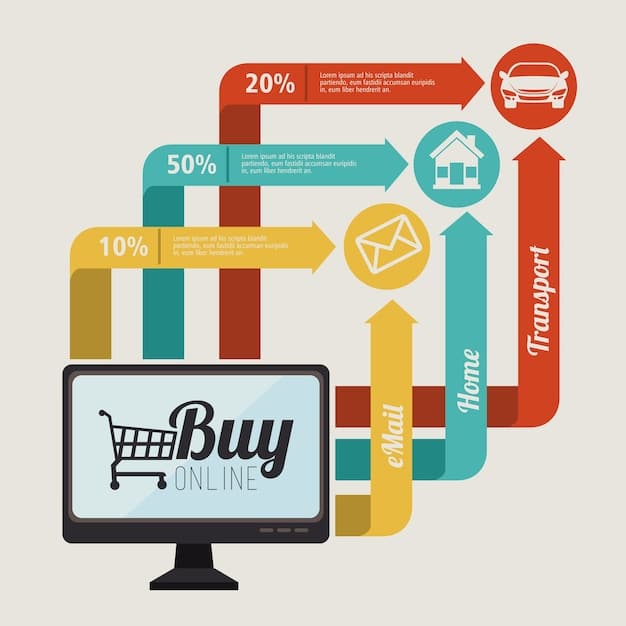US E-commerce Platform Pricing: Are You Overpaying?

US e-commerce platform pricing varies significantly, and businesses might be overpaying by 20% compared to industry averages, highlighting the importance of comparing costs and features across different platforms.
Are US e-commerce platform pricing structures leaving you wondering if you’re getting the best deal? Let’s explore the landscape to help you determine if you’re overpaying.
Understanding the US E-commerce Platform Landscape
The US e-commerce market is booming, leading to a plethora of platforms catering to different business needs and budgets. Understanding this landscape is crucial to avoid overpaying for features you might not even need.
Selecting the right e-commerce platform is a pivotal decision that can significantly impact a business’s online success. The US market offers a diverse range of options, each with its own unique pricing structure, feature set, and target audience.
Key Players in the US E-commerce Market
Several major players dominate the US e-commerce platform market, each offering a unique set of features and pricing models.
- Shopify: A popular choice for businesses of all sizes, offering a wide range of features and a user-friendly interface.
- BigCommerce: A robust platform with a strong focus on scalability and enterprise-level features.
- WooCommerce: A flexible, open-source platform built on WordPress, offering extensive customization options.
- Squarespace: Known for its sleek design and ease of use, ideal for small businesses and creatives.

Factors Influencing E-commerce Platform Pricing
E-commerce platform pricing is influenced by several factors, including the features offered, the size of the business, and the level of support required.
Several variables can impact the cost of an e-commerce platform, and it’s vital to understand these elements to choose an affordable option that matches your demands. One consideration is the number of features the platform offers. Plans can be structured on the functionality available, such as the ability to manage a certain number of products or to set up automated email marketing campaigns.
- Features: More features generally translate to a higher price.
- Transaction Fees: Some platforms charge transaction fees on each sale, impacting overall costs.
- Scalability: Platforms designed for large businesses with high sales volumes tend to be more expensive.
In conclusion, understanding the US e-commerce platform landscape and the factors influencing pricing is the first step in determining whether you’re overpaying. By carefully evaluating your needs and comparing different options, you can find a platform that fits your budget and helps you achieve your business goals.
Decoding E-commerce Platform Pricing Models
E-commerce platforms employ various pricing models, each with its own advantages and disadvantages. Understanding these models is crucial to making an informed decision.
The options are broad and may feel overwhelming, so let’s examine a few popular approaches. Pricing structures for e-commerce platforms include monthly subscriptions, pay-as-you-go, and free plans. Each one appeals to a certain kind of consumer and uses their business strategy.
Subscription-Based Pricing
Subscription-based pricing is the most common model, where businesses pay a recurring fee (usually monthly) for access to the platform.
Many platforms offer tiered subscription plans. Each subscription tier offers an incremental increase in the functionality and resources you will have access to. For example, the lowest tier on a platform may allow for the management of a smaller catalog of products and fewer options for user management.
Transaction Fee-Based Pricing
Some platforms charge a transaction fee on each sale, in addition to or instead of a subscription fee.
Platforms using transaction fee pricing models often offer lower monthly fees. However, the overall cost ends up being highly dependent on your sales volume because the transaction fees will stack up rapidly.
Open Source vs. Proprietary Platforms
Open-source platforms like WooCommerce are often free to download, but require additional costs for hosting, themes, and plugins.
Open source platforms are very flexible and allow for high degrees of customization, which can allow you to mold them exactly to your vision. One major cost associated with adopting this technology involves the need to hire developers to oversee and maintain the website’s features.
- Flexibility: Open-source platforms offer greater flexibility and customization options.
- Control: Businesses have more control over their data and platform functionality with open-source solutions.
- Cost: While the platform itself may be free, costs can arise from hosting, development, and maintenance.

In summary, decoding e-commerce platform pricing models requires careful consideration of your business needs and budget. By understanding the different models and their associated costs, you can make an informed decision and avoid overpaying for your platform.
Benchmarking E-commerce Platform Costs: Are You Above Average?
Comparing your e-commerce platform costs to industry averages is essential to determine if you’re overpaying. Benchmarking involves researching and comparing your expenses with similar businesses.
Benchmarking e-commerce platform expenditures entails matching your own costs with those of peers in the sector. This allows you to gauge opportunities for savings, and is essential for controlling expenditure.
Researching Industry Averages
Several resources provide data on e-commerce platform costs, including industry reports, surveys, and online forums.
E-commerce platform pricing information can be obtained from sources like industry reports, user satisfaction surveys, and online communities. Industry reports often contain a wealth of information about the expenditures that businesses of diverse sizes make.
Comparing Apples to Apples
When benchmarking, it’s crucial to compare platforms with similar features and functionalities. Don’t compare a basic plan to a premium plan with advanced features.
When benchmarking costs, bear in mind the characteristics and capacities of the e-commerce systems being weighed. In order to obtain meaningful insights into the amount you ought to be spending on your choice of platform, ensure that you match systems that have comparable sets of features.
Hidden Costs to Consider
Don’t forget to factor in hidden costs like transaction fees, plugin costs, and development expenses when benchmarking.
Benchmarking your e-commerce platform expenses requires consideration of indirect or hidden costs like transaction fees, costs of customization, and development expenditures. Including these expenses in your calculations will provide a more precise understanding of the true expenses associated with running your platform.
- Transaction Fees: These can add up quickly, especially for high-volume businesses.
- Plugin Costs: Many platforms require paid plugins for essential features.
- Development Expenses: Customization and development work can significantly increase costs.
Ultimately, benchmarking e-commerce platform costs is key for assessing whether you’re overspending. Conduct detailed research to comprehend industry averages, compare similar platforms, and factor in hidden costs in order to evaluate the costs associated with your e-commerce platform. By doing so, you can save money and make well-informed decisions.
Negotiating with E-commerce Platform Providers
Negotiating with e-commerce platform providers can often lead to lower prices or better terms. Don’t be afraid to ask for discounts or explore alternative pricing options.
Many people do not consider this to be a possibility, but many e-commerce platform providers are open to negotiations concerning various aspects of their service package. Contacting these services, or better yet, their competitors may often yield great results.
Leveraging Competition
Inform platform providers that you’re evaluating multiple options and encourage them to offer competitive pricing.
In order to exert influence over pricing negotiations, prospective customers can utilize the competitive dynamics in the market. You may utilize the market’s competitive climate to obtain more advantageous conditions with suppliers. Use any leverage available to you to acquire the lowest price.
Asking for Discounts
Inquire about available discounts, such as long-term contracts, volume discounts, or educational discounts.
When negotiating with e-commerce platform providers, inquire about discounts, such as long-term guarantees, annual payment reductions, educational advantages, or other special offers. Often providers are eager to strike a deal in return for a commitment, and the long-term guarantees provide financial incentives.
Customizing Your Plan
Explore the possibility of customizing your plan to remove unnecessary features and reduce costs.
Consider ways to personalize the service plan to remove features you do not need in order to minimize expenses. Contact the merchant directly to explore a plan that only includes the functionalities that are actually used.
- Identify Unnecessary Features: Determine which features you’re not using and ask to have them removed from your plan.
- Negotiate Payment Terms: Explore different payment options, such as annual billing, to potentially secure a discount.
- Seek Value-Added Services: Inquire about additional services that can be bundled into your plan at no extra cost.
To summarize, negotiating prices with ecommerce platform providers is an effective strategy for lowering costs and improving terms. Be ready to negotiate and secure ideal conditions that correspond with your financial constraints by applying tactics such as influencing rivalry, requesting savings, and customizing plans.
Switching Platforms: When Is It Worth the Cost?
Switching e-commerce platforms can be a daunting task, but it may be worthwhile if you’re significantly overpaying or if your current platform no longer meets your needs.
The option of changing e-commerce platforms has to be carefully investigated since it presents numerous obstacles and implications. However, it could effectively address concerns like expensive costs or unmet system needs.
Evaluating the Costs of Switching
Consider the costs of data migration, downtime, and employee training when evaluating whether to switch platforms.
When contemplating migrating to a different platform, it’s vital to consider the associated expenditures. Downtime, data migration, and employee training are several things to keep in mind.
Assessing Your Current Platform’s Limitations
Determine whether your current platform is hindering your business growth and if a new platform could provide significant improvements.
Is the platform at the moment imposing limitations that are interfering with business expansion? Consider whether utilizing a new platform would provide substantial improvements.
Planning for a Smooth Transition
Create a detailed migration plan to minimize disruption and ensure a seamless transition to the new platform.
To cut down on disturbances and ensure a smooth transition to the new platform, make a comprehensive migration plan. Carefully plan out how the migration process should work, keeping track of crucial points, and making sure there are resources set aside for it.
- Data Migration: Ensure all your data is accurately and securely transferred to the new platform.
- Downtime Minimization: Plan the migration during off-peak hours to minimize disruption to your customers.
- Employee Training: Provide adequate training to your employees on the new platform’s features and functionalities.
In conclusion, switching platforms may be a strategic decision to make if your current system is hindering growth or becoming unreasonably expensive. Carefully assess the expenses, platform inadequacies, and meticulously devise the transition to maximize advantages and minimize disturbances during the switch.
Future-Proofing Your E-commerce Platform Investment
Choosing an e-commerce platform is a long-term investment. Consider factors like scalability, security, and innovation to future-proof your investment.
You have to examine aspects like security, scalability, and innovation to properly future-proof your financial commitment because choosing an e-commerce platform entails making a long-term investment.
Scalability for Growth
Ensure your chosen platform can handle increasing traffic and sales volumes as your business grows.
Pick a system that is capable of handling growing traffic and sales volumes as your company grows. For a company to ensure sustained growth, scalability is of the utmost importance.
Security Considerations
Prioritize platforms with robust security features to protect your customers’ data and prevent fraud.
To protect consumer data and guard against fraud, give systems with excellent security features top priority. Prioritization of security in the modern digital era is non-negotiable.
Embracing Innovation
Choose a platform that is constantly evolving and incorporating new technologies to stay ahead of the competition.
In order to stay ahead of the competition, choose a platform that is always changing and integrating new technologies. Selecting a platform that emphasizes innovation guarantees that you’ll be able to leverage cutting-edge capabilities and developments.
- Mobile Optimization: Ensure your platform is fully optimized for mobile devices.
- AI-Powered Features: Explore platforms with AI-powered features like product recommendations and personalized marketing.
- Integration with Emerging Technologies: Choose a platform that integrates with emerging technologies like augmented reality and blockchain.
Overall, purchasing an e-commerce platform entails making a long-term financial commitment that has to be properly future-proofed. To safeguard your platform investment and ensure your company’s online success, put security, scalability, and innovation first.
| Key Point | Brief Description |
|---|---|
| 💰 Benchmarking Costs | Compare your platform costs with industry averages to identify potential overspending. |
| 🤝 Negotiating Deals | Negotiate with platform providers for discounts, customized plans, or value-added services. |
| 🚀 Scalability | Choose a platform that can handle your business growth and increasing traffic. |
| 🔒 Hidden Costs | Consider hidden costs like transaction fees and plugin expenses in your platform assessment. |
Frequently Asked Questions
Common pricing models include subscription-based (monthly fee), transaction fee-based (fee per sale), and open-source (free to download but requires hosting and development costs).
Compare your platform’s cost and features with industry averages, evaluate hidden costs, and assess whether the platform’s capabilities align with your business needs.
Hidden costs may include transaction fees, plugin or app costs, costs for customized themes, SEO costs, development expenses, security enhancements and SSL certificates, and marketing expenditures to promote your online store.
Not necessarily. Consider the costs of switching (data migration, downtime), the limitations of your current platform, and whether a new platform offers significant improvements to justify the change.
Choose a platform that offers scalability, robust security features, and embraces innovation by constantly evolving and incorporating new technologies like AI and mobile optimization.
Conclusion
Navigating the complexities of US e-commerce platform pricing requires careful research, negotiation, and a clear understanding of your business needs. By benchmarking costs, exploring alternative pricing models, and future-proofing your investment, you can ensure you’re getting the best value for your money and maximizing your online success.





